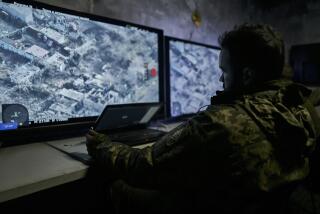Russians Pull More Bodies From Salvaged Submarine
- Share via
MOSCOW — Three bodies were recovered Thursday from the salvaged Russian submarine Kursk as experts prepared for the delicate tasks of making the vessel’s two nuclear reactors safe and removing 22 armed cruise missiles.
Investigators are working around the clock to recover the remaining bodies from the submarine at a dry dock in northern Russia. All 118 crew members perished when two explosions sank the submarine on Aug. 12, 2000, during military exercises in the Barents Sea. The cause of the blasts is still unknown.
Russian television aired footage Thursday of the barnacle-encrusted hull at a shipyard in Roslyakovo. A wreath was propped poignantly at one side of the craft.
“The main task now is to make the reactors safe,” said Adm. Vladimir Kuroyedov, chief of the Russian navy.
The recovered bodies were identifiable by sight, according to Capt. Vladimir M. Navrotsky, spokesman for the Northern Fleet, which is based in the Arctic port of Severomorsk. No notes were found, he said.
The first six investigators from the Chief Military Prosecutor’s Office entered the drained hull Thursday, examining the submarine’s three aft compartments and removing the three bodies. They sighted five more bodies nearby and planned to remove them overnight.
Twelve bodies were recovered from the far-aft ninth compartment a year ago. They included the body of Lt. Capt. Dmitry Kolesnikov, who had written a note containing the startling revelation that at least 23 men survived the blasts and gathered in the ninth compartment in their final hours. Another eight bodies are expected to be recovered from the compartment.
Recovery crews cut off the 14,000-ton submarine’s blast-damaged bow, which contained torpedoes, before raising the rest of the craft last month. Navrotsky, who walked on the Kursk’s deck Thursday, said the damage in the fore section was catastrophic.
“It was a horrible sight and I feel awful too,” he said. “The damage done to the submarine is simply catastrophic. The submarine is all twisted and warped.
“When you look at the Kursk from where the first compartment used to be, you can see everything all the way through to the third compartment,” he said. “The inside looks like it was demolished by a tremendous explosion that melted and smashed everything into a heap of scrap metal. Everything is burned out.”
Prosecutor General Vladimir Ustinov, who is in charge of the investigation into the Kursk disaster, said work to recover the bodies will continue.
Investigators hope a recording device on the bridge, located in the fourth compartment, will provide clues to the cause of the explosions. The condition of bodies, any notes left by crew members and the submarine’s log also might cast some light.
Russian authorities have announced that no details about the bodies will be released until all have been recovered and identified. The work will progress compartment by compartment and relatives will be informed as work on each area is complete, Navrotsky said.
A forensic laboratory in the closed military city of Severomorsk will assist in identification of remains.
Officials said Thursday that there was no sign of a radiation leak from the submarine reactors and no damage to the missile silos, although water will have to be pumped out of one silo. Each missile is more than 30 feet long and weighs nearly 7 tons.
Naval officials said Thursday that the missiles can be removed by conventional means, adding that the lack of electrical power on the submarine ruled out any risk that a missile might be launched accidentally during the operation.
Although experts outside Russia suggested that the likely cause of the Kursk’s sinking was a torpedo explosion within the craft, Russian authorities have insisted that the disaster could have been caused by a collision with another submarine or a World War II mine.
The damaged bow section remains on the sea floor about 350 feet below the surface, which could delay efforts to establish the cause of the disaster.
Russian authorities have announced that a plan for the raising of the bow next summer will be decided soon, possibly involving the Mammoet-Smit International consortium, which raised the hull.
More to Read
Sign up for Essential California
The most important California stories and recommendations in your inbox every morning.
You may occasionally receive promotional content from the Los Angeles Times.













